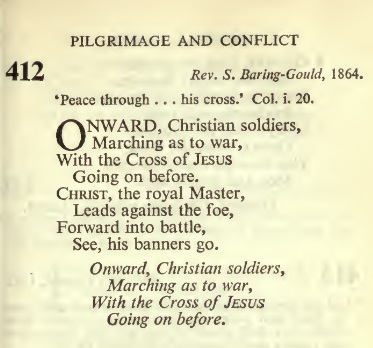

The hymn has four stanzas and one refrain.

It has since been adopted as the processional hymn of the Salvation Army and Baring- Gould's most famous hymn. Despite the corrections, thus hymn was using with its original text and published as such in many hymnals. Changes include changing one word in a line or a paraphrase of the line. Its original title was "Hymn for Procession with Cross and Banners." It was said that the lyricist, Baring-Gould wrote this hymn under 15 minutes, apologized for the haste and allowed some of the lines to be changed. The creation of the hymn was due to its use as a processional hymn for children walking from Horbury Bridge to Horbury St Peter's Church in 1865. Other people credit 2 Chronicles 20:15 or Deuteronomy 31:6, for the inspiration. The hymn is based on verse 2 Timothy 2:3.

Gertrude", after the wife of the composer, Arthur Seymour Sullivan (1842-1900). The hymn was the product of the words by Sabine Baring-Gould (1834-1924) who wrote it in 1871. Every soldier and army must have a theme, and "Onward Christian Soldiers" fits the bill. There is the never-ending battle between good and evil alongside the struggle for salvation and sin. Like many believers of other denominations, Christians are soldiers of the Faith. Underneath the themes, there are also mentions of courage, commitment, praise, encouragement, and unity. This hymn is a call for not any struggle, but the fight for Christ and Salvation. March for the Battle of the Soul: "Onward Christian Soldiers" From the title, "Onward Christian Soldiers," it is easy to say that this is a hymn of battle, warfare, soldering, and appeal.


 0 kommentar(er)
0 kommentar(er)
